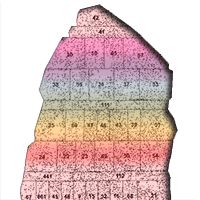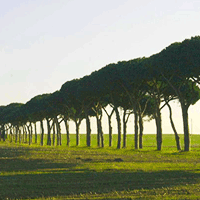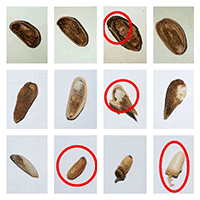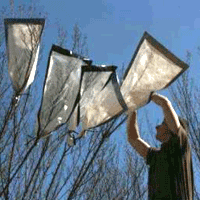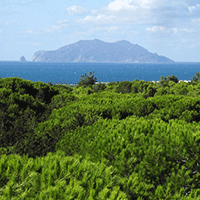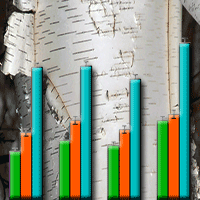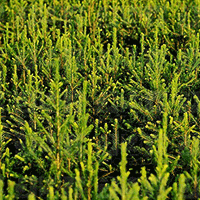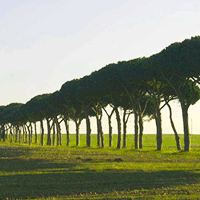
Growth of Stone pine (Pinus pinea L.) European provenances in central Chile
Verónica Loewe Muñoz (1) , Mónica Balzarini (2), Claudia Delard Rodríguez (1), Andrea Álvarez Contreras (1), Rafael María Navarro-Cerrillo (3)
iForest - Biogeosciences and Forestry, Volume 10, Issue 1, Pages 64-69 (2016)
doi: https://doi.org/10.3832/ifor1984-009
Published: Aug 29, 2016 - Copyright © 2016 SISEF
Short Communications
Abstract
Pinus pinea is characterized by phenotypic plasticity, tolerance to harsh soils and climates, but low differentiation in growth parameters and low genetic variability. Growth and cone production of six European stone pine provenances (two from Italy, three from Spain and one from Slovenia) were analyzed in a field trial experiment established in central Chile. The study evaluated height, diameter at breast height (DBH) and crown diameter growth of 147 nineteen-year-old trees per provenance, as well as fruiting variables (i.e., number of cones per tree and cone weight). Survival over the first 7 years was also evaluated. Provenances significantly differed in cone number per tree, cone weight, height and DBH growth, and crown diameter growth. Provenances were grouped according to growth and production variables: one group included the Italian and Slovenian provenances, the second group Andalucía and Sierra Morena (Spain), and the third included Meseta Castellana (Spain). Individual cone production was positively correlated with cone weight and other growth variables. Meseta Castellana provenance showed the highest growth and productivity. Our results provide useful information for the selection of P. pinea provenances to be used in new plantations in central Chile.
Keywords
Cone Productivity, Growth, Provenances, Stone Pine Plantations
Authors’ Info
Authors’ address
Claudia Delard Rodríguez
Andrea Álvarez Contreras
Chilean Forest Institute (INFOR), Santiago (Chile)
CONICET Biometry Unit, College of Agriculture, Universidad Nacional de Córdoba, Córdoba (Argentina)
DendroLab, Dpto. Ingeniería Forestal, ETSIAM Universidad de Córdoba, Córdoba (Spain)
Corresponding author
Paper Info
Citation
Loewe Muñoz V, Balzarini M, Delard Rodríguez C, Álvarez Contreras A, Navarro-Cerrillo RM (2016). Growth of Stone pine (Pinus pinea L.) European provenances in central Chile. iForest 10: 64-69. - doi: 10.3832/ifor1984-009
Academic Editor
Gianfranco Minotta
Paper history
Received: Jan 17, 2016
Accepted: May 09, 2016
First online: Aug 29, 2016
Publication Date: Feb 28, 2017
Publication Time: 3.73 months
Copyright Information
© SISEF - The Italian Society of Silviculture and Forest Ecology 2016
Open Access
This article is distributed under the terms of the Creative Commons Attribution-Non Commercial 4.0 International (https://creativecommons.org/licenses/by-nc/4.0/), which permits unrestricted use, distribution, and reproduction in any medium, provided you give appropriate credit to the original author(s) and the source, provide a link to the Creative Commons license, and indicate if changes were made.
Web Metrics
Breakdown by View Type
Article Usage
Total Article Views: 55590
(from publication date up to now)
Breakdown by View Type
HTML Page Views: 47054
Abstract Page Views: 3400
PDF Downloads: 3755
Citation/Reference Downloads: 60
XML Downloads: 1321
Web Metrics
Days since publication: 3392
Overall contacts: 55590
Avg. contacts per week: 114.72
Citation Metrics
Article Citations
Article citations are based on data periodically collected from the Clarivate Web of Science web site
(last update: Mar 2025)
Total number of cites (since 2017): 9
Average cites per year: 1.00
Publication Metrics
by Dimensions ©
Articles citing this article
List of the papers citing this article based on CrossRef Cited-by.
References
Zonas potenciales para pino piñonero en Chile [Potential zones for Stone pine in Chile]. In: “Un nuevo cultivo para Chile, el Pino Piñonero (Pinus pinea L.)” (Loewe MV, Delard RC eds). INFOR-CORFO, Santiago, Chile, pp. 241-246. [in Spanish]
Gscholar
La recolección de piñas durante la prehistoria en la Cueva de Nerja (Málaga) [Cone harvest during prehistory in Nerja cave (Málaga, Spain)]. In: “De Neandertales a CroMañones, el inicio del poblamiento humano en las Tierras Valencianas” (Villaverde V ed). Universitat de Valencia, Spain, pp. 101-104. [in Spanish]
Gscholar
Influence of stand and tree attributes and silviculture on cone and seed productions in forests of Pinus pinea L., in northern Tunisia. Options Mediterranéennes 105: 9-14.
Gscholar
Modelo interregional de selvicoltura para Pinus pinea L. Aproximación mediante funciones con componentes aleatorios. [Interregional silvicultural model for Pinus pinea L. Approximation by functions with random components]. Doctoral Thesis, Universidad Politécnica of Madrid, Madrid, Spain, pp. 300. [in Spanish]
Gscholar
Comportamiento de coníferas bajo riego en Dique Yaucha, Mendoza, Argentina. [Behavior of conifers under irrigation in Yaucha dam, Mendoza, Argentina]. Revista Facultad de Ciencias Agrarias Universidad Nacional de Cuyo 40 (1): 67-72. [in Spanish]
Gscholar
Nut pines. Yearbook, West Australian Nut and Tree Crops Association 19: 56-66.
Gscholar
Caracterização molecular de proveniências de Pinus pinea L. por RAPD (Random Amplified Polymorphic DNA) [Molecular characterization of Pinus pinea provenances by RAPD (Random Amplified Polymorphic DNA)]. Silva Lusitana 10 (1): 53-61. [in Portuguese]
Gscholar
Caracterização de par’metros biométricos e de ácidos gordos em pinhões de populações portuguesas de Pinus pinea L. [Characterization of biometric variables and fatty acids in pine nuts from Portuguese Pinus pinea L. populations]. Silva Lusitana 16 (1): 1-19. [in Portuguese]
Gscholar
Pino piñonero. Pinus pinea [Stone pine. Pinus pinea]. EUFORGEN, Guía técnica para la conservación genética y utilización del pino piñonero (Pinus pinea). Foresta 40: 2. [in Spanish]
Gscholar
Study of isozyme variation in Pinus pinea L.: evidence for low polymorphism. Silvae Genetica 46: 201-207.
Gscholar
Estaciones ecológicas de los pinares españoles. [Ecological sites of Spanish pine forests]. Dirección General para la Conservación de la Naturaleza. Madrid, Spain, pp. 184. [in Spanish]
Gscholar
Análisis de los recursos genéticos de Pinus pinea L. en España mediante microsatélites del cloroplasto. [Analysis of the genetic resources of Pinus pinea L. in Spain by chloroplast microsatellites]. Investigación Agraria: Sistemas y recursos Forestales 11 (1): 145-154. [in Spanish]
Gscholar
Ausencia de diferenciación ecotípica entre rodales selectos de pino piñonero en la cuenca del Duero. [Lack of ecotype differentiation between selected stone pine stands in the Duero basin]. Investigación Agraria: Sistemas y recursos Forestales 16 (3): 253-261. [in Spanish]
CrossRef | Gscholar
Experiencias de clareos en masas de Pinus pinea L. en la meseta Norte [Thinning experiences Pinus pinea L. forests in the North plateau]. In: Proceedings of the “V Spanish Forest Congress - SECF”. Avila (Spain) 21-25 Sep 2009. Junta de Castilla y León, Spain, pp. 13. [in Spanish]
Gscholar
Results of comparative trials between Stone pine (Pinus pinea L.) provenances in northern Tunisia. Revue Forestière Française 61 (2): 107-116.
Gscholar
SAS for Mixed Models (2nd edn). SAS Institute Inc., Cary, NC, USA, pp. 814.
Gscholar
Sicomoro, grevillea, roble rojo americano, pino piñonero, castaño, ruil y cerezo americano, nuevas alternativas para producir madera de alto valor [Sycamore, silk oak, red American oak, stone pine, chestnut, ruil and black cherry, new alternatives to produce high value timber]. INFOR-FIA, Santiago, Chile, pp. 320. [in Spanish]
Gscholar
Pino piñonero: el potencial de su madera y fruto. [Stone pine: potential of its timber and fruit]. Chile Forestal 334: 49-53. [in Spanish]
Gscholar
Introducción del pino piñonero, Pinus pinea L., en Chile [Introduction of Stone pine, Pinus pinea L., into Chile]. Ciencia e Investigación Forestal 18 (2) 39-52. [in Spanish]
Gscholar
Un nuevo cultivo para Chile, el pino piñonero (Pinus pinea L.) [A new crop for Chile, the Stone pine (Pinus pinea L.)]. Instituto Forestal. Santiago, Chile. pp. 364. [in Spanish]
Gscholar
Manual de claras para repoblaciones de Pinus pinea L. [Handbook on Pinus pinea L. plantation thinning]. Ed. EGMASA y Junta de Andalucía, Spain. pp. 47. [in Spanish]
Gscholar
Strong plasticity in a genetically depauperated tree - the fox or the hedgehog strategy? Stone pine provenances performance in Inner Spain. CIFOR, INIA, Madrid, Spain. pp. 17.
Gscholar
El pino piñonero, un pino atípico. [Stone pine, an atipic tree]. Cuadernos de la Sociedad Española de Ciencias Forestales 24: 81-85. [in Spanish]
Gscholar
Mediterranean Stone pine: botany and horticulture. Horticultural Reviews 39: 153-201.
Gscholar
Le pinete e la produzione dei pinoli dal passato ai giorni nostri, nel territorio del parco di Migliarino, S. Rossore, Massaciuccoli [Pine forests and pine nut production in the Migliarino S. Rossore Massaciuccoli ParK, from the past to nowadays]. Ente Parco Regionale Migliarino San Rossore Massaciuccoli, Pisa, Italy, pp. 134. [in Italian]
Gscholar
Las regiones de procedencia de Pinus pinea L. en España [Provenance regions of Pinus pinea L. in Spain]. Org. Autónomo de Parques Naturales, Madrid, Spain, pp. 111. [in Spanish]
Gscholar
Variabilidad fenotípica en respuesta al estrés hídrico en una especie forestal genéticamente homogénea: Pinus pinea L. [Phenotipic variability in response to water stress in a genetically homogeneous forest species: Pinus pinea L.]. In: Proceedings of the “V Spanish Forest Congress - SECF ”. Avila (Spain) 21-25 Sep 2009. Junta de Castilla y León, Spain, pp. 2-7. [in Spanish]
Gscholar
SAS® data integration studio 3.3: user’s guide. SAS Institute Inc., Cary, NC, USA, pp. 243.
Gscholar
Analyse de la chaîne de valeur “Pignons de pin” en Tunisie [Pine nut value chain analysis in Tunisia]. S.l.-GIZ, France, pp. 48. [in French]
Gscholar
Linear mixed models: a practical guide using statistical software. CRC Press, New York, USA, pp. 440.
Gscholar

